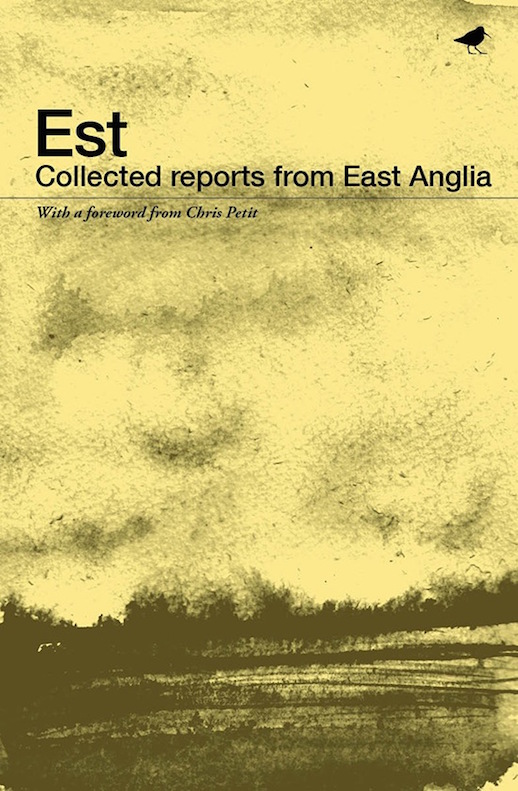 Est – Collected Reports From East Anglia
Est – Collected Reports From East Anglia
Dunlin Press. Paperback, 274 pages. Out now.
Review by Danny Adcock
East Anglia has been my home for all but one of my forty-two years. I have lived in the far South and the extreme North, from the Thames to the Wash. Whereas now my home is the rolling countryside and marshes of North-West Norfolk, until my mid-twenties it was the maze of streets, and the concrete and asphalt of Southend and its outlying villages. My parents’ village held little attraction for a teenage indie fan though, Southend was where it was at: forty-five minutes by train to London, and fifteen to the legendary Pink Toothbrush nightclub in Rayleigh, and so I moved to the relative metropolis of Southend when I was old enough to get into pubs and clubs. It’s always been a littoral existence though, never more than a stone’s throw from saltwater, and in Est: Collected reports from East Anglia, the coast is woven through its pages like an indelible thread, with a sense of permanence that belies the fragility of much of the East Anglian shoreline.
Place, landscape and memory are at the forefront of much of the writing within Est, and anybody familiar with East Anglia will find much that they identify with if they have their own realities of it. The first piece holds huge significance for me, for it is Essex which is a ‘constant tax’ on author David Southwell’s memory. From the ‘punching neon of Southend’s seafront,’ inland to where ‘the rivers Crouch and Roach become confused,’ I’ve walked the paths he describes that lead ‘to the lip of the land.’ The writing is punchy and minimal, the short staccato sentences rattling his descriptions out. It describes how landscape can possess you, and how the landscape is older than the county itself, which is something that is somehow, sometimes, the most important part of any landscape. It epitomises the book in its entirety.
Landscape and place writing can sometimes be ambiguous, ethereal even, as can be its sister-genre nature writing. On the whole the writers in Est have avoided that trait. That describing a sense of place can sometimes engender ambiguity is not surprising when you try to pin down what ‘sense of place,’ is. There are many strands that contribute: memory, history – both ancient and modern – tradition, folklore, legend, architecture, emotion, art, writing, the list is theoretically infinite. Many of these strands are considered throughout Est. From Black Shuck the spectral dog that stalks the North Norfolk marshes, and was the inspiration for The Hound of the Baskervilles, to the ancient realities of Seahenge and Sutton Hoo; from J.A. Baker’s ‘peregrine country,’ to the ‘bothersome’ traffic noise of the A12, much of the writing addresses the varying strands of East Anglia’s places, its cultures and histories.
Norfolk is a county without a single motorway (and long may it remain so), but though it is mainly a rural county, there are centres of population, the biggest being the city of Norwich. Ella Johnstone’s insightful piece about the city’s increase in the use of food banks may at first glance seem out of place in a book dealing largely with landscape and place memoir. But taken in context it is actually one of the most relevant. Place and landscape are nothing without people to engage with them. East Anglia is not merely a place for people to exist in. It is a place that should be relevant to everybody, where everybody, whatever their background, should have the opportunity to develop their own ideas of place, whatever they may be. North Norfolk, as in many coastal areas today, is a ghost town in Winter. To drive through any of the villages along the coast road after dark is to drive past darkened cottage after darkened cottage. ‘Rural Norfolk re-imagined for a metropolitan elite,’ as Laurence Mitchell describes it in his piece Drift, where occupation is ‘transient,’ and which style magazines describe as ‘undiscovered.’
Est has a refreshing breadth. From the North of East Anglia to the South; to if the far South of Essex is even part of East Anglia (it is); from an artist’s-eye-view to a sound-recordist’s perspective. Unafraid to break from the middle-classness that dogs much landscape, place and nature writing, Est examines the ‘Warping gravity of place,’ with open eyes, and some sharp, intelligent and relevant writing. Books like Est must be able to be written again by the next generation. We can’t let a kind of austerity of culture mean only the ‘elite’ have the opportunity to examine our landscape in any depth or detail.